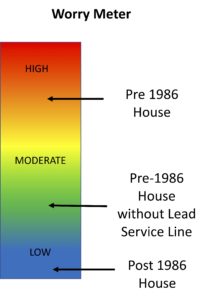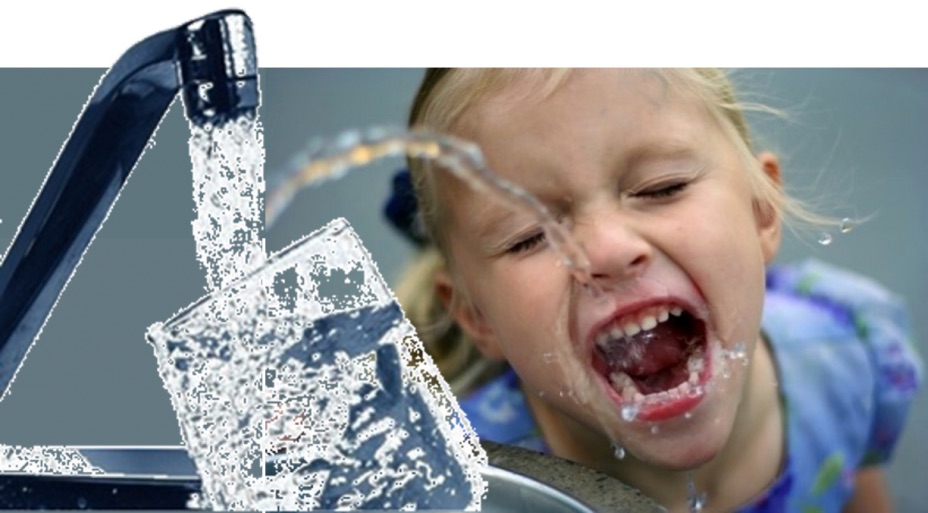
I can think of no better way to convince someone of the risk from lead in drinking water than to defer to the least public health protective Administrator in the history of the EPA, Scott Pruitt, who declared a “War on Lead”, calling lead in drinking water, “one of our greatest challenges in this country” because of its threat to the “mental acuity of our children”. Need I say more?Given this received wisdom, we are left with the simple question: Are you at risk and, if so, what should you do?
A 1986, federal law banned almost all lead from residential construction, eliminating almost all lead from houses built after that date. If you live in a post-1986 house relax and read no further. If not, read on.
| Option | Cost | Benefit (0-5) |
| Replace Lead Service Line | $5,000 | 4 |
| Replace Pipes | >$10,000 | 2 |
| Cartridge Filter | $100 – $500 + $20-50/year | 0-4 |
| Reverse Osmosis Filter | $300 – $1,000 + $30-70/year | 4-5 |
| Flush Pipes Before Use | <$10/year | 3 |
EXPOSURE
There are three possible sources of lead in your drinking water:
- Service lines
- Solder
- Fixtures
If you have one, a lead service line is, by far, the most important source of lead in your drinking water. There are several ways to find out if you do. A.) Some cities, such as Seattle, have a website that allows you to look up your home and see if you have a lead line. B.) Your home’s inspection report should list whether or not the house has a lead pipe. C.) Trace your plumbing back to the pipe that brings water into your house. If this pipe is dull gray in color and curved, it’s probably lead. If you can scratch it easily with a key, assume it’s lead. D.) a licensed plumber can check the pipe for the minimum service call fee ($75-$150). If you have a well, alicensed well water contractor can help you determine if any of the well components are a source of lead for about the same cost.

Even if you do not have a lead service line (or you have it removed), you can still have lead in your water from solder (if you have copper pipes) or from brass fixtures, which may have alloys containing lead.
Risk
Lead is extremely toxic, particularly for young children and developing embryos, primarily through its effect on the nervous system. (for those interested in the details, I will be posting some links to key research) The toxic effects of lead include lower IQs, behavioral and developmental issues in children, and, in adults, high blood pressure and kidney disease. Current research suggests there is no safe level of lead in the human body. It is particularly destructive to young children and developing embryos. If you have a lead service line in your household plumbing system, you need to address it.
The Fix
In an ideal world, there would be no lead in any water distribution system, but, if you have a lead service line and/or pre-1986 plumbing, you have lead in your water.
Your options for removing lead are:
- Replace your lead service line.
This is ideal, but costly and will, in most cases, still leave you with lead in your water from solder and fixtures. So, do this if you can, especially if you are remodeling anyway, but there are other, cheaper options. - Replace the pipes.
This very costly, but, if you have pre-1986 copper plumbing, it is the only way to eliminate all of the lead in your water once the service line is fixed. Do it only if you are remodeling anyway. Otherwise, don’t bother. - Install a cartridge filter.
You only need this for cooking and drinking water so the kitchen sink and any refrigerator water and ice dispensers should have filtered supplies. (Pitchers are better than nothing, but not optimal because of their limited capacity.) Not all cartridge filters remove lead, so it is essential to make sure it does. You will also need to be fastidious about changing the cartridge. Filters have the added advantage of removing other contaminants such carcinogenic chlorination byproducts.
Note that the biggest cost of a filter is the installation. If you can do it yourself you can dramatically reduce the cost. If you need a plumber, grab your checkbook. - Install a Reverse Osmosis filter [BEST OPTION]
Reverse osmosis (RO) filters give you extremely pure water. They are used to desalinate seawater and produce bottled water. They need to be installed under the kitchen sink. You will need to include piping to the refrigerator if you have a water or ice dispenser. - Run the tap water in the morning before using [LOW COST OPTION]
If you have limited money, this is an extremely cheap option that will dramatically reduce your exposure to lead in drinking water. Lead leaches into water as it sits in the pipes for a long period, such as overnight. Run the water until it’s cold. Cheap, simple, and effective.
Bottom Line
If cost is no object, remove the lead from your plumbing, but the best option is a filter, which I recommend even if you don’t have lead in your plumbing, because it eliminates other risk factors. Install a RO filter if you can afford it, but a cartridge filter can be very effective. Be sure to include the refrigerator in your consideration and to change the cartridge religiously.
If money is tight, run the tap until the water runs cold before drinking or cooking with it.
How to Raise Clean Kids in a Dirty World 1, #cleankidsdirtyworld


